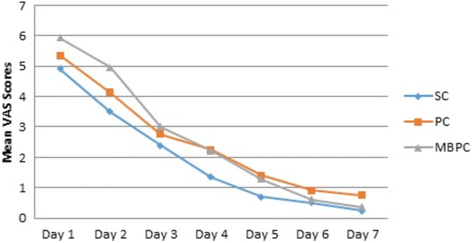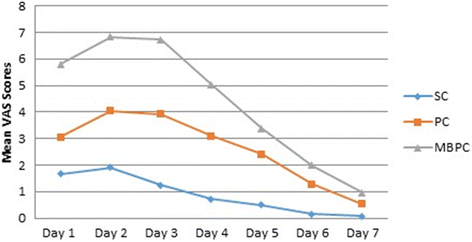How effective is collagen resorbable membrane placement after partially impacted mandibular third molar surgery on postoperative morbidity? A prospective randomized comparative study
- PMID: 28982352
- PMCID: PMC5629786
- DOI: 10.1186/s12903-017-0416-z
How effective is collagen resorbable membrane placement after partially impacted mandibular third molar surgery on postoperative morbidity? A prospective randomized comparative study
Abstract
Background: Collagen membranes have some benefits include promoting wound healing through isolation, clot stabilization, wound stability, and hemostasis, enhancing primary wound coverage through its chemotactic ability to attract fibroblasts, and augmenting flap thickness by providing a collagenous scaffold. The purpose of this study was to compare primary and secondary healing and collagen membrane-based primary healing after surgical removal of partial impacted mandibular third molars, evaluating the incidence of postoperative complications and analyzing the swelling, mouth opening, and pain.
Methods: This was a prospective, randomized controlled study. Patients were randomly assigned to three groups: the SC (Secondary closure) group, the PC (Primary closure) group, and the MBPC (membrane based primary closure) group. Data were collected on pain, mouth opening, swelling, and complications experienced by the patients.
Results: There was no statistically significant difference between the groups for the pain (p > 0.05), relatively. The swelling recorded on postoperative days 2 and 7 was lower in the SC group than in the PC (p = 0.046 and 0.00) and in MBPC (p = 0.005 and 0.002) groups, respectively. Mouth opening showed a statistically significant difference between the three groups at day 2 (p = 0.00). Wound dehiscence was shown in 6 patients in the PC (20%) group and 2 patients in the MBPC (6.7%) group. Dry socket was observed 3 patients in the SC group (10%), 2 patients in the PC group (6.7%), and no dry socket in the MBPC group. No cases of infection or postoperative bleeding were encountered.
Conclusions: The secondary closure provides a marked advantage over the primary closure in terms of swelling and mouth opening. However, the absence of alveolitis in the primary closure using the collagen membrane and minimal wound dehiscence, suggests that membrane use may support primary healing in terms of wound healing.
Keywords: Collagen resorbable membrane; Mandibular third molar surgery; Partially impacted tooth; Postoperative morbidity.
Conflict of interest statement
Ethics approval and consent to participate
This study was carried out at the Department of the Oral and Maxillofacial Surgery of the Ataturk University Faculty of Dentistry (Erzurum, Turkey). This study followed the Declaration of Helsinki on medical protocol and ethics and the regional Ethical Review Board of Ataturk University Faculty of Dentistry approved the study, and informed consent was obtained from all patients or parents or legal guardians. Informed consent to participate was obtained in writing from participants after explaining the study purposes, methodology and possible future publication of clinical datasets.
Consent for publication
Not applicable.
Competing interests
The authors declare that they have no competing interests.
Publisher’s Note
Springer Nature remains neutral with regard to jurisdictional claims in published maps and institutional affiliations.
Figures
References
Publication types
MeSH terms
Substances
LinkOut - more resources
Full Text Sources
Other Literature Sources
Medical



